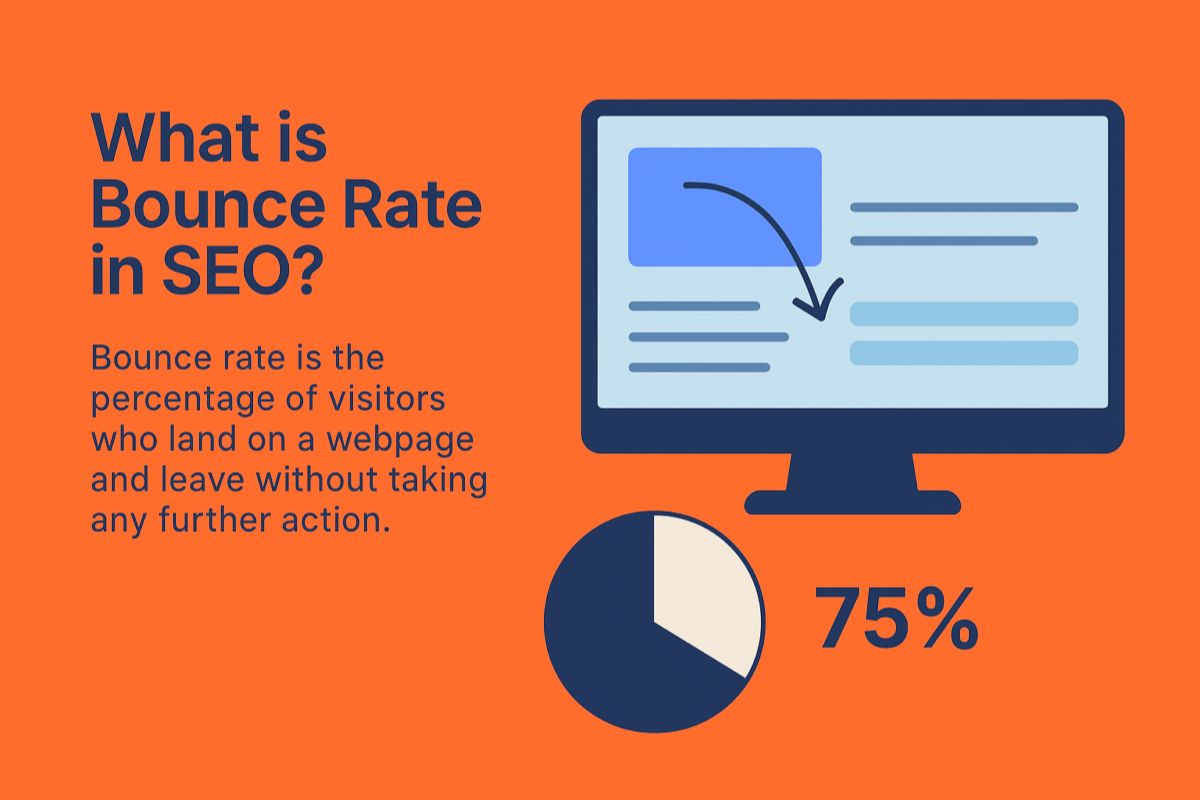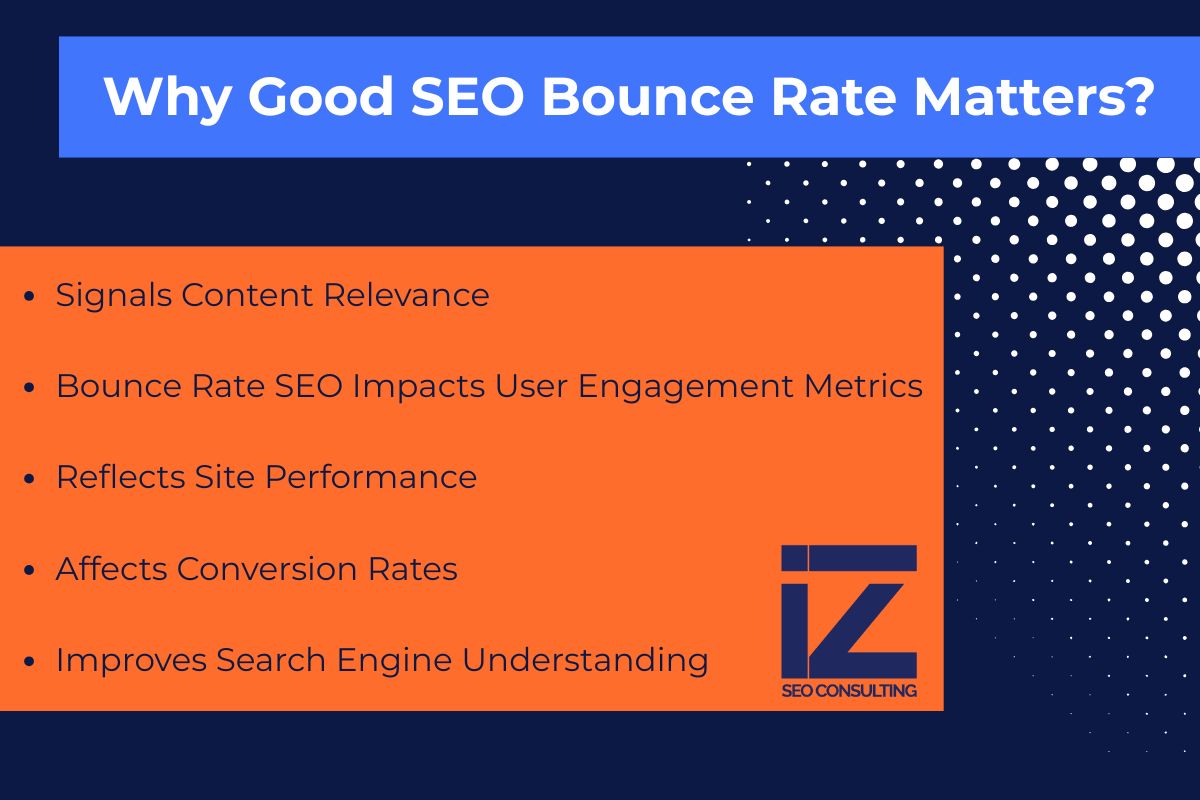Bounce rate is one of the most frequently discussed SEO metrics in digital marketing and search engine optimization. Yet, it remains misunderstood by many. Understanding SEO bounce rate and its impact is crucial for any business or website seeking online visibility, traffic retention, and conversions. So, today we will learn everything about a good SEO bounce rate and explain how bounce rate affects website SEO. We will cover how it’s calculated, why it matters for SEO, and how businesses can improve it to optimize website performance. Let’s begin.
What Is a Bounce Rate?
Right from the start, we will clear the confusion and explain the bounce rate SEO meaning. SEO bounce rate is a metric that indicates the percentage of visitors who land on a webpage and leave the site without taking any further action. Actions such as clicking a link, filling out a form, or navigating to another page. In simple terms, it measures single-page sessions.

For example, if 100 users visit a website and 40 of them leave without interacting beyond the first page, the bounce rate is 40%. SEO bounce rate is tracked by analytics tools like Google Analytics and helps measure user engagement and content relevance. Now that we know the SEO bounce rate definition, we can understand why a good SEO bounce rate is important.
Why Good SEO Bounce Rate Matters
Although bounce rate is not a direct ranking factor in Google’s algorithm, it serves as an important indicator of a website’s user experience and content quality. Here’s why it matters:
- Signals Content Relevance
A high bounce rate may indicate that visitors are not finding what they expected based on the search query or meta description. Search engines interpret this as a sign that the content may not be relevant or useful. - Bounce Rate SEO Impacts User Engagement Metrics
Lower bounce rates often correlate with higher session durations, multiple page views, and conversions. All positive signals to search engines. - Reflects Site Performance
Bounce rate can uncover issues like slow load times, poor design, misleading headlines, or mobile unfriendliness. These factors, in turn, affect SEO performance. - Affects Conversion Rates
A user who bounces is a lost opportunity. For businesses, this means missed leads, sales, or signups, directly impacting the bottom line. - Improves Search Engine Understanding
Google may use aggregated engagement metrics to refine how it ranks pages. Sites that keep users engaged are more likely to be rewarded.

What Is a Good Bounce Rate for SEO?
There is no universal benchmark for a “good” bounce rate. It varies by industry, content type, and page purpose. However, general guidelines suggest:
- 25–40%: Excellent. Especially for e-commerce and service sites.
- 41–55%: Average.
- 56–70%: Higher than average, may need optimization.
- 70% +: Considered high, but context is crucial.
For instance, a blog post or news article may have a high bounce rate simply because the user finds the information they need quickly and leaves. This isn’t necessarily bad.
Common Reasons for High Bounce Rate
- Slow Website Loading
If a page takes too long to load, users are likely to abandon it before even viewing the content. - Poor User Experience
Hard-to-read fonts, intrusive pop-ups, broken links, and confusing navigation can frustrate users. - Misleading Meta Tags
If the page’s title or description doesn’t align with the actual content, users will exit immediately. - Non-Mobile-Friendly Design
With most users accessing websites on mobile devices, unresponsive design leads to high bounce rates. - Lack of Clear Call-to-Action (CTA)
If users don’t know what to do next, they’ll likely leave.

How to Reduce Bounce Rate for Better SEO
- Improve Page Load Speed
Use tools like Google PageSpeed Insights to identify performance bottlenecks. - Create Relevant and High-Quality Content
Ensure that content delivers on the promise made in the headline and meta tags. - Enhance Readability and Layout
Use bullet points, subheadings, images, and white space to make content more digestible. - Optimize for Mobile Devices
Ensure responsive design and functionality across all devices. - Include Internal Links
Encourage visitors to explore related articles or services with strategically placed internal links. - Use Clear CTAs
Tell users what to do next. Subscribe, download, contact, or read more. - A/B Test Landing Pages
Regularly test and tweak content layout, headlines, CTAs, and media to optimize engagement, maintain, and create search-optimized content.
Bounce Rate and Different Page Types
- Blogs & News Sites: May have naturally high bounce rates. Consider measuring “time on page” instead.
- Landing Pages: Should have lower bounce rates due to conversion focus.
- E-commerce Sites: Product pages should ideally lead users to other products, or a cart—a high bounce rate here could mean a lost sale.
- Support or FAQ Pages: A high bounce rate may not be negative if the user found the answer and left satisfied.
The Role of Google Analytics
Google Analytics offers multiple insights to help assess, improve, and maintain a good SEO bounce rate:
- Behavior Flow Reports: It helps you understand how users move through your site.
- Audience Segments: Compare bounce rates by device, location, or traffic source.
- Landing Pages Report: Identify which pages have the highest bounce rates and need attention.
By combining bounce rate data with other engagement metrics like average session duration, goal completions, and exit rate, you can get a clearer picture of overall performance.
FAQ: Bounce Rate SEO
Does bounce rate affect SEO rankings?
Bounce rate itself is not a direct Google ranking factor. But it influences user engagement signals like time on site and page interaction. These indirectly affect SEO rankings as they show how valuable your content is to users.
What are the benefits of SEO for businesses bounce rate?
SEO can attract more qualified traffic by targeting relevant keywords and improving site structure. When the right audience lands on optimized pages, they are more likely to stay and engage. This reduces bounce rates and increases conversions. Hence, SEO is strengthening your brand through proper tactics, and one of them is bounce rate monitoring.
How can I track bounce rate in GA?
Navigate to Google Analytics > Reports > Engagement > Pages and screens. There, you’ll see the bounce rate per page. Custom dashboards and segments allow further analysis by source, device, and demographic.
Is a high bounce rate always bad?
Not always. For single-purpose pages like blog posts or contact pages, users may get exactly what they need and leave. The context of the page’s goal matters when evaluating bounce rate.
Can bounce rate be artificially lowered?
Yes, but it’s not recommended. Tactics like forced redirects or auto-playing videos may keep users longer, but hurt UX. The goal should be genuine engagement through valuable content and seamless design.
How do internal links affect bounce rate?
Strategic internal linking guides visitors to other relevant content, increasing their time on site and reducing bounce rate. It also distributes link equity across your site, supporting SEO efforts.
Conclusion
By now, you should have an idea of what SEO bounce rate is. A good SEO bounce rate is a crucial metric that reflects how well your site retains and engages visitors. While a high bounce rate doesn’t always indicate failure, consistent patterns across key pages can reveal deeper usability or content issues. By monitoring bounce rate and making informed SEO adjustments, you can deliver better user experiences, retain more visitors, and ultimately, drive more conversions. But if you do not know how to apply best SEO practices, consult with Indexed Zone SEO and have your business and online presence thrive.



